July 2007
Monthly Archive
GeneralTuesday, July 31st, 2007, (8:51 pm)
SHOCK VALUE
This afternoon I was giving my friend Donna a ride to the train station on the way she asked me to take her to the sex store in town. Now, as much as you might not believe this, I don’t usually frequent sex stores. Indeed I have only ever been to sex stores in Amsterdam, Frankfurt, Portland, and Houston. But now that I actually see those locations in a list it would seem that I travel the world visiting sex stores, which I don’t. But before this hole caves in on me allow me to continue…
Donna wanted to drop by the store quickly so she could find an outfit for work (needless to say she’s not a school teacher or a nun). I was going to stay in the car so as to encourage her to not waste and thus allow me to get on with the rest of my day. However, my curiosity got the better of me so I decided to join her into the store.
In a sex store, ones shockability regulator has to be cranked up to its highest tolerance level. Such places are a moral minefield for the masses, and and eye opening education that often leaves you wishing you had left your eyes tightly closed.
I like to think I’m an open minded chap, but such stores always leave me feeling like a happy clapper Christian blissfully unaware of life beyond the church doors. If our life’s sins were measured on a scale of 1 to 10, then ironically sex stores make me feel like I’m still only on a three or maybe a four.
Behind these blacked out windows I realize that there are a whole host of sins that not only have I not yet committed, but I simply have no desire to commit them! This is perhaps good news for my soul, though if visiting a porno store makes you feel virtuous it could be suggested your moral barometer is a little off.
As Donna browsed the various slinky things that go by the economic model of ‘less is more’, I decided to take a look at what the little store had to offer the would be shopper. I chuckled to myself at the various range of inflatable dolls on offer wondering who the heck would buy such a thing. Surely if times were bad enough that you were considering the ‘love’ of an inflatable companion, wouldn’t you buy it online and have it shipped in a discreet unmarked package? In fact, this thought crosses my my mind as I look at many of the things of the shelves.
At the moment I came across a large box containing an inflatable sex doll called ‘Fatty Potter.’ I began feeling too much like a raincoat wearing deviant, so I retreated back to the relative safety of Donna’s company that somehow made my presence here feel legitimate. Just then I spotted a range of dildo’s that were surely a joke.

I Drew Donna’s attention to the huge black sex toys which, like me, she looked at in disbelief. She exclaimed, in more detail than was required, that she wouldn’t be overly comfortable even attempting the use of such devices. As she held the ‘Anal Grenade’ package in her hands I couldn’t help wonder how one would bring up the idea of introducing a “Anal Grenade” or “Butt Buster” into ones bedroom activities?
Laughing at the ridiculous nature of the toys Donna then turned her attention to the amusingly named ‘War Head’, an impossibly large penis shaped dildo that comes with a set of free dog tags!? (I’m not even going there in my mind!)
“Do you actually sell any of these?” Donna asked clerk who looked more like a prayer group leader than what you might imagine a sex store clerk to look like. “Actually, since we got them we’ve sold quite a lot of that range… all to guys.”
And there it was, another shock.
Photography and TravelWednesday, July 11th, 2007, (9:14 pm)
OUT THERE
I don’t live far from the beaches that look out at the Irish Sea and across the mouth of both the River Dee and the River Mersey. On countless occasions I’ve sought some kind of refuge in moments looking out over the water, and no matter how many times I’ve stood on a beach looking out across the waves, the allure has never failed to captivate me.

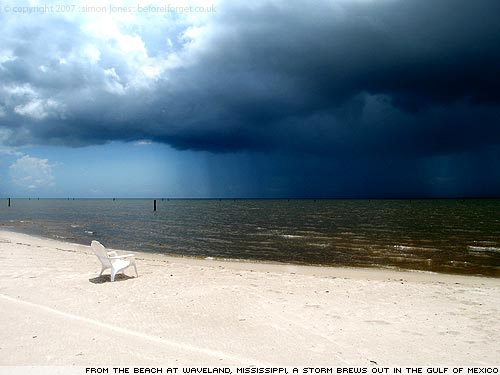
I took these pictures standing on the beach at Waveland in Mississippi. Looking out toward the Gulf of Mexico there was a storm brewing. Rain fell from dense dark clouds that hovered over the water like an alien mother-ship. I stood there in the sunlight watching the dark clouds advance slowly like an ancient army of invaders coming over a hill to do battle.
On a different day I marveled at the towering mega-structure clouds that seem to hang in the air locked in shapes that reminded me of the photographs of galactic star-forming pillars of gas and dust taken by the Hubble space telescope.


And finally, who wouldn’t want to be sat there on the beach in that last picture? When I tell people I visited Mississippi they often look at me with an expression that begs a further explanation. “Mississippi?” They ask. “What’s in Mississippi?”
I’ll confess now that I’m tempted not tell them.
TravelTuesday, July 10th, 2007, (7:07 pm)
THE RETURN TO WAVELAND
In April 2006 I visited a town called Waveland in Mississippi, to assist in the ongoing cleanup operation after hurricane Katrina all but wiped the small Gulf Coast town off the map back in August 2005. Now 15 months later I’ve returned to Waveland to see the area that resembled a war-zone last time I was here.

The scale of destruction caused by hurricane Katrina is almost impossible to comprehend. We’ve all seen the television footage and dramatic pictures from New Orleans and other Katrina hit areas, but as arresting as they might be nothing can quite prepare you for the experience of seeing the devastation first hand.
Nearly two years after Katrina hit you might assume that America, the richest nation on earth, would have fixed everything that the storm smashed. This is after all a country that is capable of spending more than two hundred million dollars a day on a seemingly endless war in a far off land. Surely then, cleaning up after a hurricane would be a breeze.
Of course, the issue isn’t that simple. There are various factors that complicate the process of rebuilding. The promised $85 billion of Federal aid has been slow to trickle through to all those who need it, and there are still many claims that not enough is being done on federal and state levels.
Much of the destruction affected private property which lead to the insurance industry struggling to settle the $34.4 billion of claims. But as high as the figure for insured losses may be it pales when compared with the $125 billion figure for total economic losses of hurricane Katrina estimated by Risk Management Solutions, a risk modeling agency from Newark, California.
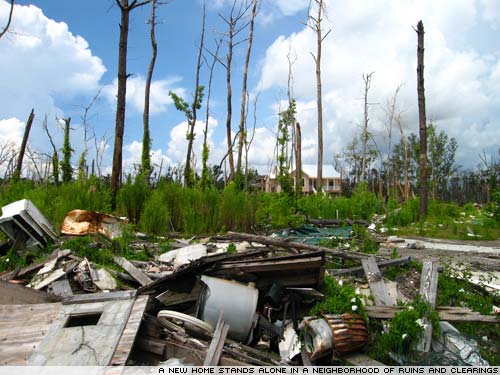
The majority of those worst affected by Katrina suffered from flood damage caused either by a failure of the levies in New Orleans, or by huge 35 foot storm surge waves that crashed into coastal towns like Waveland. However, insurance companies have rejected many claims made after hurricane Katrina based upon the understanding that private insurance companies do not cover flood damage, no matter if that flood was a direct result of a hurricane weather system. This assertion by private insurance companies has left many people in quite awful financial situations, often paying mortgages on houses that simply no longer exist, and lawsuits against insurance companies look unlikely to succeed.
“Unfortunately many people choose not to buy flood insurance even though it can be immensely invaluable. The policies under the National Flood Insurance Program will pay up to $250,000 for residential buildings plus another $100,000 for contents. The average premium is around $400 a year for $100,000 worth of coverage.” Said Carolyn Gorman, vice president of the Insurance Information Institute.
“If you live in a flood plane your bank will require you to have flood insurance when you get your mortgage. Unfortunately many people let that policy lapse, leaving them uncovered when a disaster occurs. If your home is totally destroyed and you can’t make your mortgage payments on a home that no longer exists, then your bank will probably foreclose.”

As an outsider looking in on this situation it’s perhaps too easy for me to make sweeping judgments about who I think isn’t doing enough, and what more needs to be done. But I have to temper my disappointment at seeing the many FEMA trailers parked in neighborhoods that have simply vanished, with the fact that there are a great many people actively working to assist in the the recovery of this region.
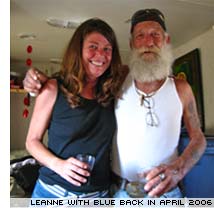 Leaving the trailers behind
Leaving the trailers behind
In her rickety FEMA supplied trailer on the plot of what used to be her home, I spoke once more with Leanne, whom I had met last year. “This is a new trailer,” She told me as we sat at her dinner table. “It’s bigger than the last one.”
Last time I was here Leanne smiled for a picture in her tiny trailer with her friend ‘Blue’ who has since passed away. I’ve often thought about Leanne and wondered how she was doing. I doubt I’ll forget the tour of her house that she gave us last year. Katrina had completely destroyed her home leaving just the flooring as evidence of the house that once stood. “This is the kitchen.” She said, while stood not far from a smashed car, snapped trees, and a painted sign that read ‘Rosey, Rest in Peace.’
Leanne is soon to be rehoused in a Katrina Cottage, a low cost housing unit created to help replace the 65,000-plus Mississippi homes lost to the hurricane. Designed in the style of a downscaled Mississippi-style coastal cottage, the 308 square foot properties come complete with a porch and oversized windows to give the property an airy spacious feel. They’ve already proved very popular not only in Katrina hit areas but across the country with developers considering the design for high-end beach communities on other coasts.
Leanne is excited at the prospect of moving out of her FEMA trailer at long last, though it will be a bitter sweet moment as she will no longer be on the plot of her former home just a block away from the beach.
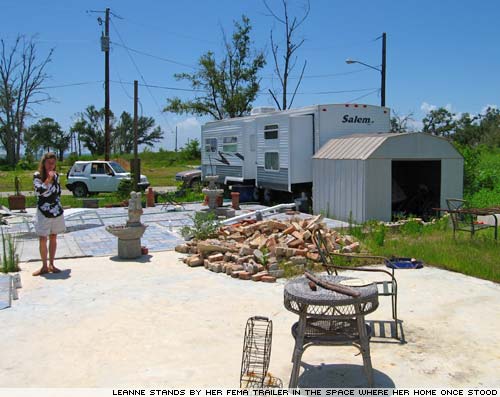
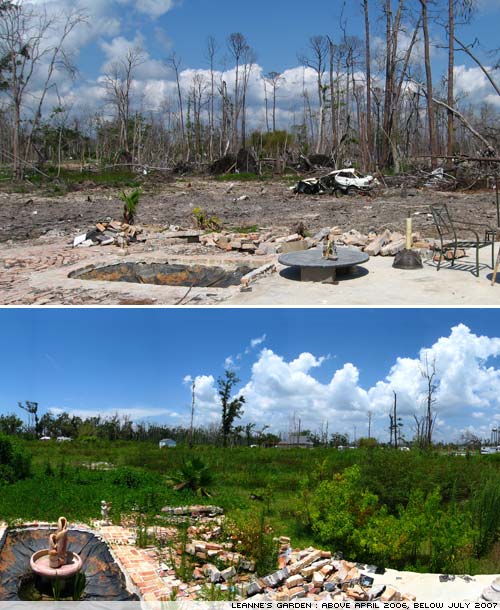
In my collection of photographs shown here I wanted to try and find comparisons of the same locations taken first 6 months after the storm, then again at this time, nearly 2 years after the storm. The difficulty is that actually identifying locations is almost impossible given the lack of recognizable landmarks. Even locals struggle to identify photographs of areas that at one time might have been instantly recognisable.
A very obvious difference is the $267 million reconstruction of the two-mile highway 90 bridge that now stands 85 feet high at its tallest spot as it connects Bay St. Louis to Pass Christian.
Opened amid a rousing celebration in May 2007, the bridge is seen by many as an essential lifeline and a symbol of resilient progress. Bay St. Louis Mayor, Eddie Favre, hailed the bridge a tremendous psychological and emotional boost.
“People saw it as an absolute necessity.” He said. “For 626 days, we felt that isolation. The bridge, in so many ways, whether it was walking or fishing, was just so much a part of our daily life.”
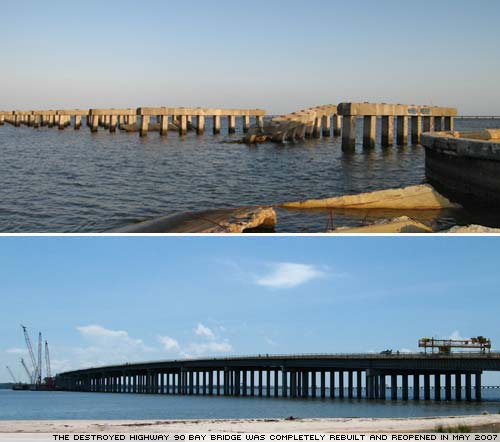
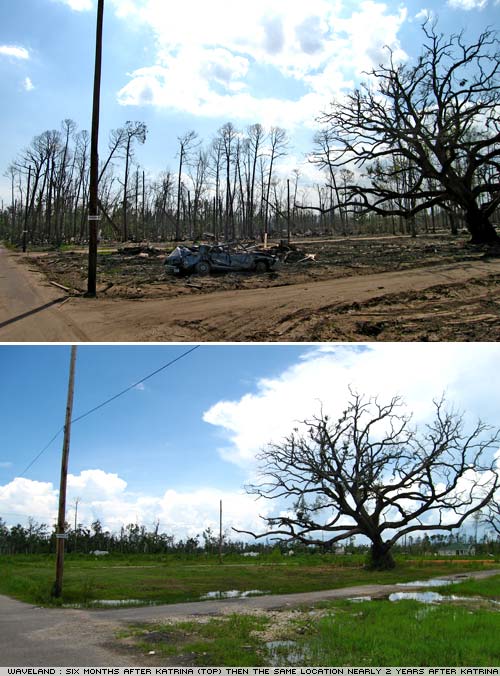



Bobbie’s house
In the days that followed Katrina various internet bulletin boards were swamped with messages from people anxious to find information of family and friends. “I am desperately seeking Rachael Fleuriet from Waveland and Bobbie Durkovich from Bay St.Louis.” Read a message from Dandy Blethroad posted in a comment on the weather.com blog.
Some sixth months later myself and two other volunteers were at the home of Bobbie Durkovich putting up dry wall. She was a smiling good humored lady who fueled us with ice cold cokes as we worked in her flood damaged house.
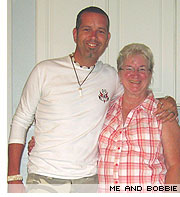 I was keen to see Bobbie again on my return to the area. When we left Bobbie back in April she hugged all three of us and cried as she thanked us and told us how proud our parents should be. Amid the wreckage of Katrina much of what we did felt somewhat deflating due to the fact there was simply so much more that needed to be done. But with Bobbie’s house, despite wanting to stay there until the job was finished, we could at least see very real signs of progress, progress that other volunteers would continue.
I was keen to see Bobbie again on my return to the area. When we left Bobbie back in April she hugged all three of us and cried as she thanked us and told us how proud our parents should be. Amid the wreckage of Katrina much of what we did felt somewhat deflating due to the fact there was simply so much more that needed to be done. But with Bobbie’s house, despite wanting to stay there until the job was finished, we could at least see very real signs of progress, progress that other volunteers would continue.
Bobbie greeted me with a broad smile and a heartfelt hug. “Come on in.” She said, proudly showing me her completed kitchen along the way. I was pleased to see her in what was once again a homely space. She showed me the hallway by her front door where fellow volunteer, Keith, had turned the air blue with his colorful language as we put up the dry wall. I’d never done any kind of building work before, and I had no idea what one of my tasks, ‘mudding’, actually entailed. These were new skills I learned in Bobbie’s house, and as she showed me the various rooms we had worked on I joked with her that my ‘mudding’ effort looked better than I imagined it might.
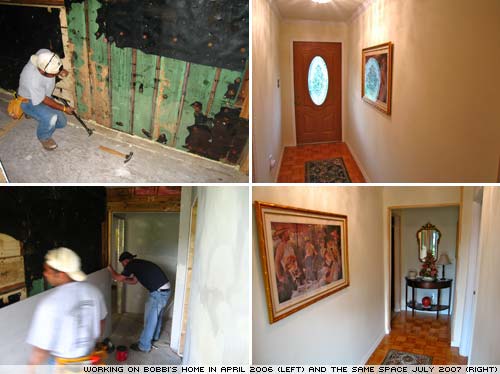

This is our home
Looking at these pictures and remembering that these photographs are taken nearly 2 years after hurricane Katrina struck, one might find themselves wondering why anyone would choose to rebuild and live in an area where the risk of this kind of destruction were a possibility.
My friend Susan Stevens, a Waveland resident whom I met while volunteering in 2006, answers that question. “We return and rebuild because this is our home.” She writes in her own Katrina story.
“We have friends here that have known us all our lives. Our families are here. Our memories are here. We have spirit and commitment and this is our home. What we lost was ‘stuff’. What we have gained cannot be measured by words.” Put in those terms it’s easy to relate to how important the idea of ‘home’ actually is.
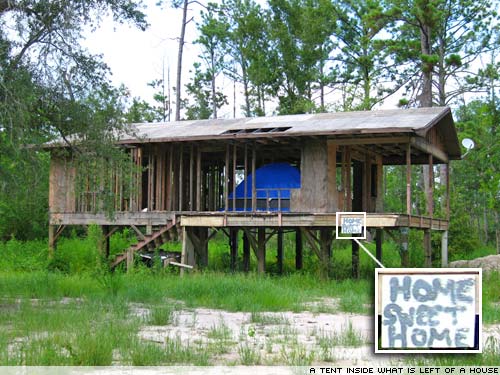



There’s still a long way to go for the residents of Gulf Coast. The challenges of rebuilding homes, and returning the communities and neighborhoods to something nearing their pre-Katrina state is a monumental task.
I never saw the Mississippi Gulf Coast before Katrina, but the few pictures I’ve seen leave me hoping that this area manages to stave off the advances of high rise condo developers who will surely seek to snap up and develop land next to the sun soaked beaches. Such developments could bring tourists and money but at the same time would very likely steal the small town charm that makes places like Waveland feel like home, or at least what we would all like home to feel like.
—
A town called Waveland
Hurricane Katrina
Hurricane Katrina stories website
Rising from ruin : MSNBC Katrina special
US coast guard : Before and after Katrina photography
A Bridge Restores a Lifeline to a Battered Town
‘Katrina Cottages’ : Home after a FEMA trailer
‘Katrina Cottages’ prove popular
Buy a ‘Katrina Cottage’
Hurricane Katrina stats
[Map] pPre-Katrina Waveland Sattalite view
[Video] My video shot 6 months after Katrina
[Video] Christ Church Bay St. Louis
[Video] Katrina Insurance Claims Hearing: Rep. Taylor Testimony
[Video] Katrina Stories: Johnny, Bay St. Louis
[Video] CNN Presents : Bay St. Louis – The town that fought back (Part 1)
[Video] CNN Presents : Bay St. Louis – The town that fought back (Parts 2,3,4,5, and 6)
Photography and TravelMonday, July 9th, 2007, (9:03 pm)
CREEPY CRAWLIES
I thought I would post these pictures I took of some of the creepy crawlies that were just hanging our Susan’s house in Mississippi.
Actually one of the things I most enjoyed in Mississippi and Texas was sitting outside in the evening or at night, and listening to the amazing amount of noise that the tree frogs, toads, crickets, cicadas, and other creepy crawly things out there.
Of course the tree frogs, gecko’s and other crawlies have adapted to living in the company of humans. Susan’s house had tree frogs and gecko’s on the outside walls much to the displeasure of her daughter, Laura, who would pick up the garden hose and spray water at a tree frog if it was on the front door when she came home!





—
[Video] A short video of the black caterpillar pictured above
TravelSunday, July 8th, 2007, (11:57 pm)
MR BLUE SKY
There’s something about a blue sky that just makes me happy. I don’t know if that’s a chemical, or physiological reaction. All I know is that in my world when the sun shines good things happen.
 In Mississippi there was no shortage of blue sky as Susan and I set off for West Ship Island, a barrier island some 12 miles off the Mississippi Coast in the Gulf of Mexico. (I like writing that, ‘The Gulf of Mexico’, it just sounds so tropical to me!)
In Mississippi there was no shortage of blue sky as Susan and I set off for West Ship Island, a barrier island some 12 miles off the Mississippi Coast in the Gulf of Mexico. (I like writing that, ‘The Gulf of Mexico’, it just sounds so tropical to me!)
We jumped on the noon ferry from Gulfport just in the nick of time before it set sail on the crossing that takes about an hour. As we boarded I asked the Captain what the conditions were like as I was somewhat weary that an hour long ferry ride might take its toll on me if the crossing was choppy. He assured me it would be calm and joked that it was very bad the previous day.
“Do you get sick?” Asked one crew member. Feeling a little foolish to only be thinking about this possible issue now, I tried to play down the fact that boats can make me feel like I am about to die. “Oh no, well you know just a little, sometimes, not often though. It looks calm today so I’ll probably be fine… right?” If they detected any apprehension in my tone they were kind enough not make anything of it.
“Do you have any ginger?” Asked one of the crewman. “Ginger works wonders. Let me see if I have any. You go an get yourself situated and I’ll come find you if I have any.” That’ll be that southern hospitality again, I thought to myself as we boarded and found a seat on the deck. Sure enough, just as the boat began moving the friendly crewman found me and gave us some sugared ginger.



We didn’t have much time on the island when we arrived so we used the time to just go for a leisurely stroll. We explored Fort Massachusetts, an historic fortress built nearly 150 years ago that has withstood the devastating force of both hurricanes Camille and Katrina.
Susan and I took off our shoes and left them by the lifeguards hut. We ambled along the white sandy beaches that make this little island such an attraction, occasionally wading knee deep into the warm clear tropical water. Along the way I decided to attempt taking a self-timer picture of the two of us. The result was as bad as the idea itself, but something about the comical picture makes me smile each time I look at it.
Later that same day we were out on another boat, this time belonging to Jeff and Moli, friends of Susan. They had invited us, along with Susan’s other friends, Mary Kay, Andrea, and Cindy, to join them along with on a boat ride out to an alligator infested part of the St Louis Bay to go swimming!
The trip was accompanied with a fairly potent punch that had me feeling relaxed and mellow about my impending death match with a hungry adult alligator. Little did they know it, but as we swept along the water to the alligator infested lake I was looking at the others in the boat trying to work out who among us might look more appetizing to the alligators. In the end though Jeff decided to abandon the idea due to the fact that the sky that had been blue all day long, was now turning dark as storm clouds gathered in the distance. Only here could a closing storm be viewed as more dangerous than an encounter with an alligator at dinner time!
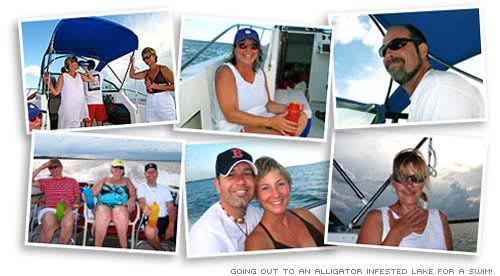
—
West Ship Island
Satellite view of West Ship Island
The story of West Ship Island’s destroyed lighthouse
Art and TravelSaturday, July 7th, 2007, (11:55 pm)
THE PERFECT DAY
The date was 07/07/07 and Casinos everywhere were probably bursting with all those people who didn’t choose this day to get married. Lady luck probably hadn’t been this over-worked since she was wearing platform shoes and listening to ‘Rumours’ by Fleetwood Mac way back in the summer of 1977. With all the sevens aligned in numerological synchronicity this day was set to be the perfect day, and for me at least, it worked out to be exactly that.
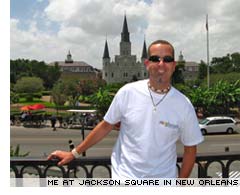 “Ladies and gentlemen, on behave of the Captain and first officer I would like to welcome you all to New Orleans.” Crackled the standard airline etiquette over the in-flight PA system as the plane I was on touched down in the ‘Big Easy.’ Passengers reached for the cell phones while readying themselves for the scramble to leave the aircraft. For the first time on this particular trip my flight was on time, and as we taxied to the gate I looked out of the window at the sky scanning for the dark clouds I’d left behind in Texas. They were nowhere to be seen.
“Ladies and gentlemen, on behave of the Captain and first officer I would like to welcome you all to New Orleans.” Crackled the standard airline etiquette over the in-flight PA system as the plane I was on touched down in the ‘Big Easy.’ Passengers reached for the cell phones while readying themselves for the scramble to leave the aircraft. For the first time on this particular trip my flight was on time, and as we taxied to the gate I looked out of the window at the sky scanning for the dark clouds I’d left behind in Texas. They were nowhere to be seen.
“Please remember to check you have all your belongings with you, and if you have stored anything in the overhead bins please take care when opening them as items do occasionally shift on take off and landing.” Continued the flight attendant. I collected my things excitedly, today I was going to meet New Orleans.
My friend Susan met me at the airport, smiling and as welcoming as she had been when I first came to know her last year. Back then I was in her home state of Mississippi with a small group from Massachusetts who had travelled there to do hurricane Katrina clean-up work.
Susan could easily be a poster girl for the ‘southern hospitality’ people talk about. From her FEMA trailer she cooked us dinner and made us margaritas every night. Her generous spirit and seemingly unending good cheer made her temporary home an oasis amongst the wreckage left behind by the devastating hurricane. We’ve been friends ever since and I was excited not just for the opportunity to see New Orleans, but also for the opportunity to get to spend time with Susan under more normal circumstances. The plan was to spend the day in the city before heading back to Mississippi in the evening.
We stepped out of the airport terminal into the clotted Louisiana air that was boiling like soup on a stove. Susan had a plan which she relayed to me in her musical sounding southern accent. “We’re going to drive down St Charles Avenue so you can look at the mansions. Normally we would take the street car but they’ve not got that working there yet since the storm.” If I were a better tourist I would have done a little research about New Orleans and might then know what or where St Charles Avenue was. But in new cities I tend to take each moment as they come, discovering the place in the same way that a white water rafter discovers the rapids.
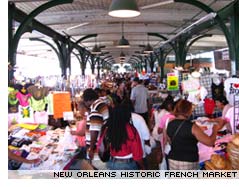 We drove past those impressive historic mansions of St Charles Avenue in the Garden District on our way to the French Quarter. Once there we parked near Jackson Square and began Susan’s walking tour of New Orleans. First stop was a visit to Central Grocery to get a Barq’s root beer and a traditional New Orleans sandwich called a Muffuletta which I can only un-poetically describe as being full of meat, cheese, and olives.
We drove past those impressive historic mansions of St Charles Avenue in the Garden District on our way to the French Quarter. Once there we parked near Jackson Square and began Susan’s walking tour of New Orleans. First stop was a visit to Central Grocery to get a Barq’s root beer and a traditional New Orleans sandwich called a Muffuletta which I can only un-poetically describe as being full of meat, cheese, and olives.
Susan assured me that a muffuletta is a New Orleans ‘must-have’, and that a visit to this city should certainly include a visit to Central Grocery to get one. We ordered ours ‘to go’ then sat on the Riverwalk beside a levee overlooking the Mississippi river.
From there we walked the short distance to the sweltering confines of the bustling French Market with its stalls selling everything from foods and postcards to voodoo dolls and alligator heads! With no real time constraints to worry us we meandered along the residential back streets chatting and exchanging stories as we made our way toward Bourbon Street. Along the way we took in the colorfully painted homes and occasionally peered through closed gates at the hidden courtyards behind them.
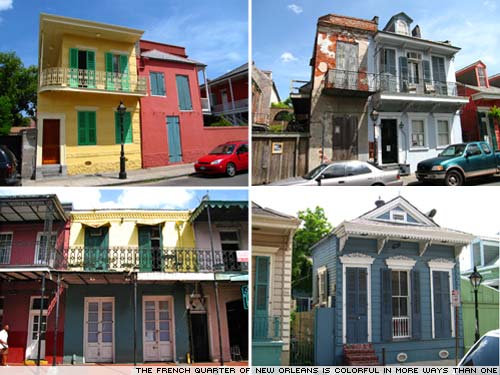

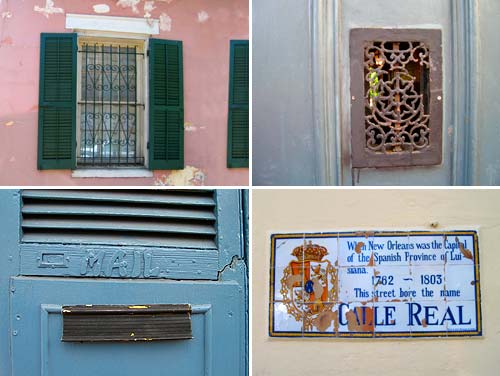
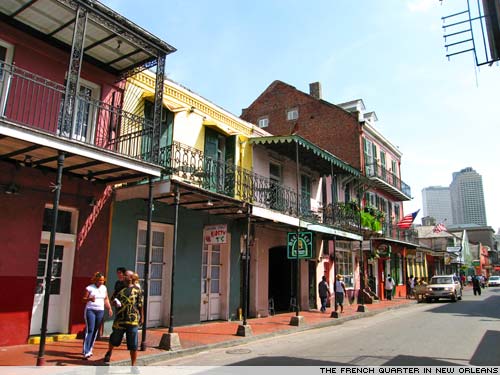
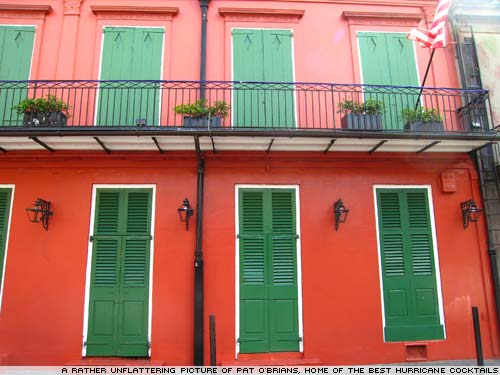
On Bourbon Street Susan took me to Pat O’Briens for a hurricane cocktail, another essential experience on her ‘must-have’ tour of the city. We sat for a short while to rest our feet and enjoy the welcome chill of air-conditioning before continuing on our wandering way with our hurricanes in hand.
We walked along Bourbon Street through the fog of live music as the sound from the various bars and clubs was already spilling onto the streets and blending with the humid afternoon air. In the doorway of a small bar we stood for a moment and watched a band play smooth jazz. The trumpet player was young while the drummer looked like he might have been playing in bars for 50 years or more. I suspected that this unlikely group of friends had probably been thrown together by their love for the music they performed so effortlessly.
Next stop on Susan’s ‘must-have’ walking tour was the Acme Oyster House. Susan was excited that I’d never eaten raw oysters before and explained that the Acme House was famous for serving the best raw oysters in New Orleans. She ordered a half dozen telling the bar tender “He’s a raw oyster virgin.”
The plate arrived quickly and Susan explained the best way to enjoy raw oysters in a way that made me feel like I was watching a TV travel show hosted by her. She ate the first one then collected up and prepared another lifting up the fork and offering it to me. No thank you wasn’t an option, so with tribal consideration of not wanting to upset the host I took the food offered to me. “Good?” She asked looking for reaction on my face. I nodded and mentally made a note to remember what this tasted like knowing that when it comes to food I have an abysmal memory. Between us we finished up the oysters then continued our leisurely stroll.
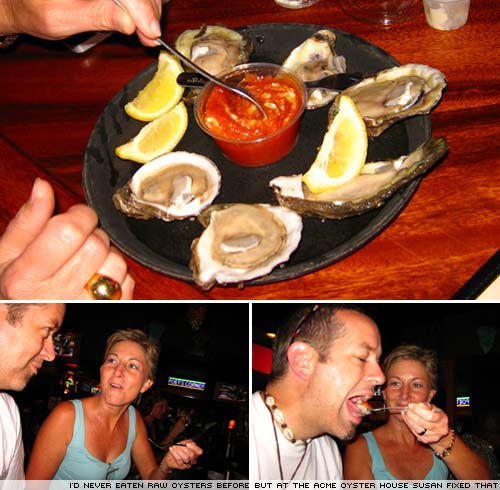
On Royal Street we browsed a handful of art galleries and antique shops pointing out the wonderful and the weird. In one gallery Susan was particularly taken with a sculpture called ‘Whirlwind’ by Martin Eichinger. I looked at the various paintings by Marc Chagall and was drawn into a simple painting of a barn in a field called ‘Arbol en la Manana’ by Jose Basso.
From the window of the Angela King gallery a large portrait of a woman caught my eye. It was painted in a linear ‘drizzle’ style similar to that of Jackson Pollock. I later learned the striking portrait was titled Deserie and is one of many similar portraits by Andrew Baird.
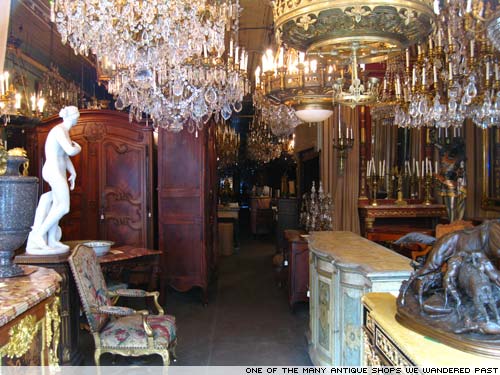

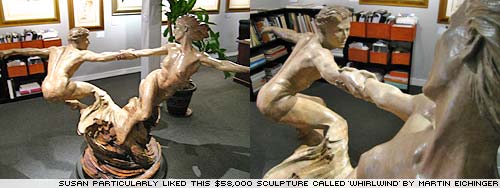

Another ‘must-have’ tour stop was for a Pimms Cup at the Napoleon House on Chartres St. From there we walked slowly to Jackson Square where we looked at more art, this time by local artists who had hung their paintings on the railings of the square beside the stalls they had set up.
We wandered into the St. Louis Cathedral for a quick look before sitting on a bench outside among the tarot card and palm readers who were doing brisk business on this sunny afternoon. “I can read palms.” Susan announced. “Really?” I said. “Oh sure, here give me your hand and I’ll read yours.” Maybe it was the mix of the Hurricane cocktail, the Acme House beer, and a Pimms Cup that made me just accept that Susan could indeed read palms, or maybe I was just going with the mood of the day as I offered her my palm.
She carefully studied the creases and impressions of my palm pointing out my lifeline. “See this line?” She said while pointing vaguely. “These are children see? You’ve got 4 lines but they’re broken which means those were children you didn’t have but could have.” I squinted and looked closer trying to see the four children in my palm as Susan continued. “But this line here tells me that there will be one child in your future.” “Really?” I questioned still examining my palm with her. “No,” She said smiling. “I’m making this up.” I laughed, realizing that New Orleans had one more sucker!
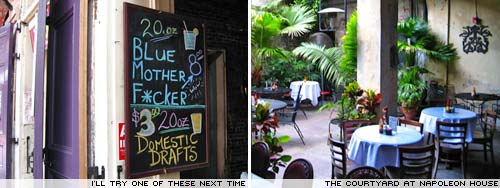

The final ‘must-have’ stop on Susan’s walking tour of New Orleans was Café du Monde, right back where we started at the French Market. Here we had Café Au Lait and the café’s famous Beignets, a powdered sugar coated fried fritter that really hit the spot! I was hungry and feeling somewhat light-headed after the cocktails and beer, so the coffee and Beignets were welcome indeed.
I probably could have walked further, but Susan’s walking tour of the Big Easy was a perfect blend of ‘must-have’ experiences and unique moments that can only happen between friends on a day like today. We had shared numerous stories with one another, and along the way had created this one, our shared 07/07/07 story; The meandering tale of what truly was a perfect day.
—
Make your own muffuletta
Recipe for a good hurricane
Recipe for a bad hurricane
Garden District mansions
New Orleans French Quarter
Acme Oyster House
Windsor Fine Art Gallery
Napoleon House (for a Pimms cup)
Jackson Square
Read your own palm
Café du Monde
[Music] The Weepies – ‘Painting by Chagall’
Next Page »









 Leaving the trailers behind
Leaving the trailers behind






 I was keen to see Bobbie again on my return to the area. When we left Bobbie back in April she hugged all three of us and cried as she thanked us and told us how proud our parents should be. Amid the wreckage of Katrina much of what we did felt somewhat deflating due to the fact there was simply so much more that needed to be done. But with Bobbie’s house, despite wanting to stay there until the job was finished, we could at least see very real signs of progress, progress that other volunteers would continue.
I was keen to see Bobbie again on my return to the area. When we left Bobbie back in April she hugged all three of us and cried as she thanked us and told us how proud our parents should be. Amid the wreckage of Katrina much of what we did felt somewhat deflating due to the fact there was simply so much more that needed to be done. But with Bobbie’s house, despite wanting to stay there until the job was finished, we could at least see very real signs of progress, progress that other volunteers would continue.










 In Mississippi there was no shortage of blue sky as Susan and I set off for
In Mississippi there was no shortage of blue sky as Susan and I set off for 



 “Ladies and gentlemen, on behave of the Captain and first officer I would like to welcome you all to New Orleans.” Crackled the standard airline etiquette over the in-flight PA system as the plane I was on touched down in the ‘Big Easy.’ Passengers reached for the cell phones while readying themselves for the scramble to leave the aircraft. For the first time on this particular trip my flight was on time, and as we taxied to the gate I looked out of the window at the sky scanning for the dark clouds I’d left behind in Texas. They were nowhere to be seen.
“Ladies and gentlemen, on behave of the Captain and first officer I would like to welcome you all to New Orleans.” Crackled the standard airline etiquette over the in-flight PA system as the plane I was on touched down in the ‘Big Easy.’ Passengers reached for the cell phones while readying themselves for the scramble to leave the aircraft. For the first time on this particular trip my flight was on time, and as we taxied to the gate I looked out of the window at the sky scanning for the dark clouds I’d left behind in Texas. They were nowhere to be seen. We drove past those impressive
We drove past those impressive 













